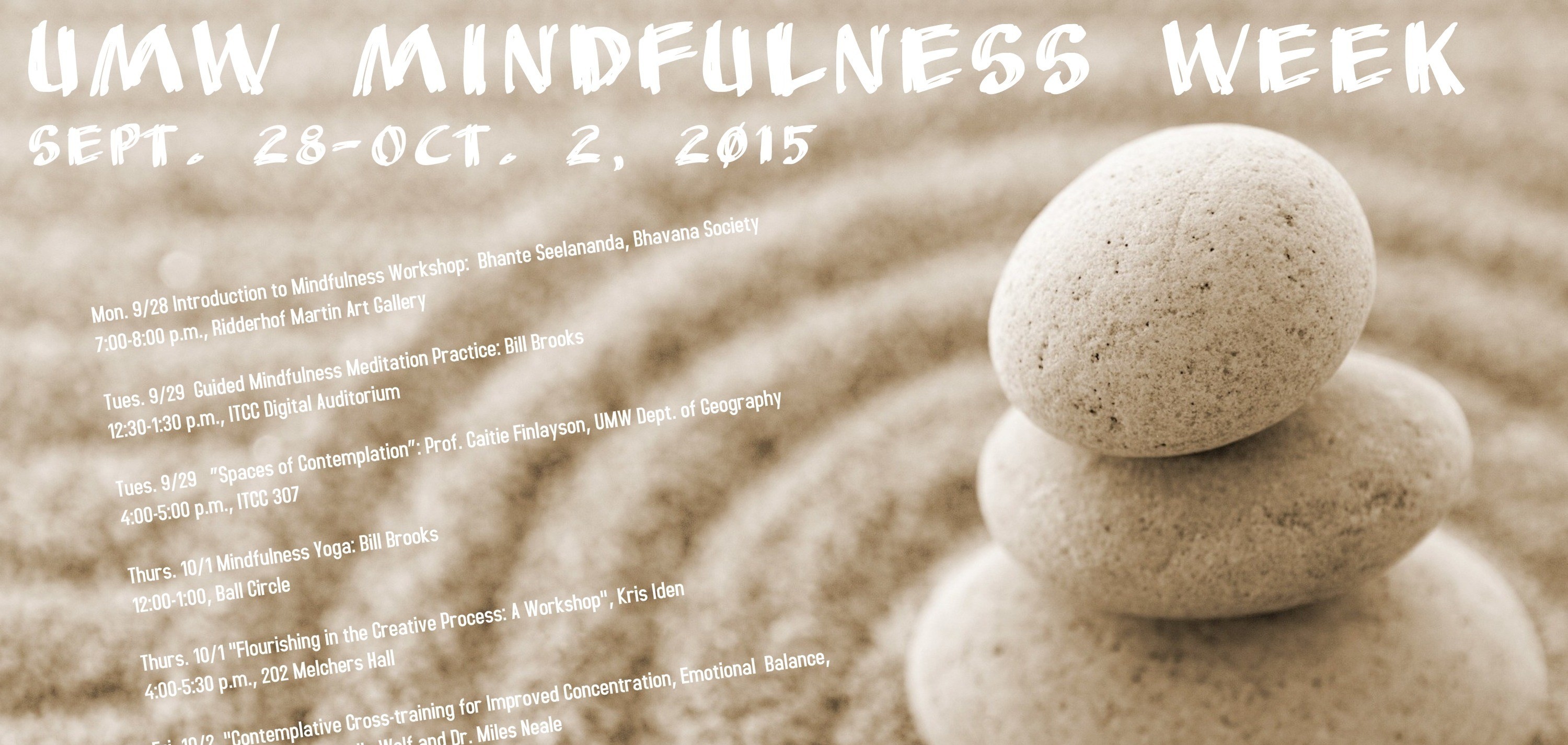Students and faculty make most of Mindfulness Week
3 min read
University Relations
By ESTER SALGUERO & EMILY HOLLINGSWORTH
This week, the University of Mary Washington is highlighting the importance of living in the moment by hosting Mindfulness Week.
Mindfulness Week, beginning Sept. 28 through Oct. 2,includes activities ranging from silent meditation and reflection to workshops that describe mindfulness and its benefits.
So mindfulness, what is it?
Angela Pitts, associate professor of classics, gives her definition of the term. “A useful definition of ‘Mindfulness’ that I find helpful is ‘moment-to-moment, nonjudgmental awareness of what actually is,’” Pitts said.
The goal of hosting this week-long event, now in its third year, is to encourage students, faculty, staff and the community to use mindfulness in their daily lives.
Several events are still to come, including the week’s keynote speaker. Dr. Miles Neale, assistant director of the Nalanda Institute of Contemplative Science, will be presenting on the transition of mindful meditation, from its origin in Indian Buddhism 2,500 years ago to becoming increasingly used in therapy and educational programs in Western civilization today. Neale will explore how mindful meditation can be integrated into psychotherapy to lighten the effects of anxiety, depression and other mental health issues.
Neale, who is a Buddhist psychotherapist in private practice, believes the mind is integral in determining happiness and quality of life, and deserves researching and utilizing mindfulness.
“The single most important factor in determining the quality of our experience–either misery or happiness–is the mind. Therefore, the single most important investment of our time of our time and energy in this life is the cultivation of the mind toward awakening,” Neale said on his website.
People can be hard on themselves. For students facing all of the stress and insecurity that can come with the college experience, Pitts encourages students to focus on the nonjudgmental aspect of mindfulness, and learn how to treat themselves as well as they treat their friends and professors.
“The non-judgmental stance in in Mindfulness is critical because it allows for the development of self-compassion, without which compassion for others is not fully possible,” Pitts said.
By learning the ways in which mindfulness can beneficially affect your life and the lives of people in your community, Pitts hopes students will be inspired to practice mindfulness in order to “enrich their physical, mental, and emotional well-being.”
One way students can begin to practice mindfulness is by finding a space of contemplation.
Professor Caitie Finlayson who has devoted her career to understanding religious spaces of contemplation in relation to the geographical aspect surrounding these places finds that awareness of “the spaces we occupy can give us a sense of spirituality and affect our mood.”
During her presentation she expressed how becoming acclimatized to a space of contemplation has a way of relieving stress in that “there’s no clocks, there is no time limit.” Without time constraints, an individual’s mood is affected in a positive way because there is no abstract ‘authority’ pressing on them to use their time wisely. Instead, students can explore ways to release energy peacefully.
Finding connections to a space that can then be call sacred heightens a person’s sense of spirituality and provides an area for thoughts to become organized. In many ways, meditation and contemplation are a forms of organization for thoughts which creates a clear perception of self.
According to Alyssa Zanzucchi, a sophomore majoring in Environmental Science, her interpretation of mindfulness after the presentation is about “being lucid of surroundings, how you react to them, letting thoughts arise and pass in an objective way to attain some form of peace.”
During the presentation, students responded to a question regarding what space they think of as serene with places in nature. One student described her hammock in the backyard where the rays of light shone through the spaces in between the leaves and the breeze that provided that area of serenity. Zanzucchi envisions her place of contemplation as “somewhere [she] can be alone in nature to feel a sense of connection.”
Becoming aware of the surroundings in a sacred place of contemplation and connecting to them in a way that allows people to relate creates an interaction with nature which provides some people with a deeper understanding of interrelatedness. As Pitts realizes in her own experience, “when I am mindful of my breath, I am aware that I am breathing oxygen that trees and other plants have generated in their own metabolic cycles.” Through this experience of interrelatedness community and purpose become valued part of daily life.












Mindful? Lets be mindful of the fact that an islamicphobic hate crime occurred in Mason. Lets be mindful of the fact that the school has made it even more daunting for victims of rapeculture to come out. What is this inane hippy bullshit? If we want to be happy on this campus then school has to start owning up to its mistakes and actively trying to create a community in where everywhere feels safe. This sounds like something privledged white folk can do inbetween classes to get the stress of having too much reading to go out on a thursday night.